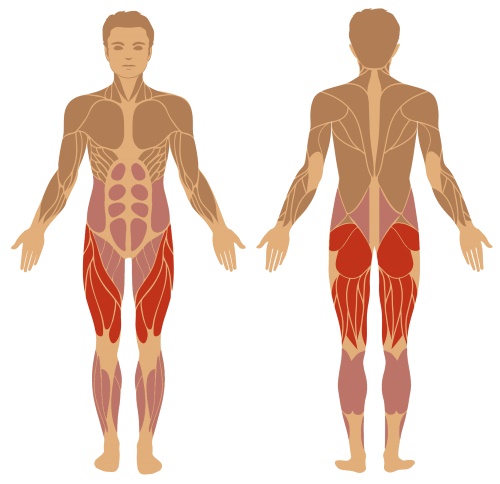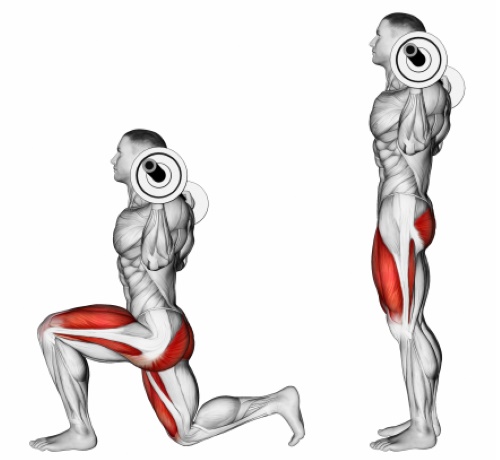Correct lunges – execution and variations
Lungees is a popular and effective leg exercise. Done correctly, it can be used to target the muscles of the thighs and glutes. This exercise is also very suitable if you want to build muscle in these regions.
At the same time, lunges also train your balance and coordination. This brings an interesting aspect to your workouts that can be especially valuable if you are doing your strength training as a complement to another sport. For example, a football player will regularly receive attacks from a good coach in his plan.
In any case, it is important to do the exercise correctly. This is the only way to use it effectively and minimize the risk of injury.
So that you can quickly get an overview of the most important information about this exercise, I have divided the article into the following sections. You can quickly reach each of them with one click:
After reading the article, you should understand why lunges can make sense and whether this exercise is right for you. You should also know what really matters with good technology.
Three reasons why you should lunges
Legends are often used in bodyweight training. They are also very often performed by athletes whose main sport is not strength training. But why is that? Why lunges are good? When and why should you include them in your leg workout plan?
I mostly only have squats and deadlifts in my leg workout plan and rarely lunges. Depending on personal goals, preferences, and general conditions, lunges can be a valuable centerpiece of your training plan. There are several very good reasons for this:
1) Lungees are functional
What movement is as functional as doing steps under load? The lunge steps mimic the sequence of movement that is natural for your muscles and thus trains the required muscle parts in a completely natural way. The kinetic chain is very long and mostly spreads throughout the body.
2) Most of the leg muscles are tense
If you do your lunges correctly, you will train most of your leg muscles at the same time. This will save you a lot of time instead of training all the muscles individually with isolation exercises. I will go into more detail on core muscles in the next section.
3) Useful for coordination
Banjos have a decisive advantage over other basic exercises: here you not only train your strength. Your coordination is also trained to a much greater degree than most other strength exercises.
This is due to one-sided loading and horizontal movement during exercise. For example, unlike squats or deadlifts, this adds an extra training component. I like to call the lunges a 3D strength exercise because there is a lot of movement in space.
For this reason (in addition to high functionality) it is very efficient to switch to other sports. I am particularly familiar with use cases in ball sports, but also in various disciplines of athletics.
Which muscles train the lunges best
Lungees are functional and target different muscles. But what exactly happens in the case of lunges? The following illustration should give you an overview of the most important muscles involved:

As mentioned earlier, primarily the muscles of the thigh and buttocks are trained in the lungs. The decisive factors are the gluteus maximus (gluteus maximus / platform) and the quadriceps femoris (leg extension). The leg biceps are also used to a lesser extent.
Other leg muscles also play a role in movement. You and the core muscles support and stabilize movement.
Do your lunges right – you have to pay attention
Lungees can also be classified as a difficult basic exercise. The exercise is not easy to master. However, if you can do it really well, you will definitely benefit from it during your workout. There are essentially a few things you should pay attention to.
So how do lunges fall out? What you should pay attention to? In choosing the following tips, I looked for common mistakes and exchanged ideas with other coaches about what has the greatest impact on clean movement. First of all, it is important to think about what should be achieved with the exercise. Pay attention to the following rules and you will quickly learn good performance.
1) Wide hips standing over all movement
Start the lunges with a straight hip, hip-width apart. The width of the step should not change per step. So you take a straight step forward. You don’t have to step outward. This is primarily a load on your tendons and ligaments.
After each lunge, you return to the starting position with your feet before starting the next rep.
2) Find the correct stride length and save it
Finding the right move can be a little tricky at the beginning. Therefore, you must first practice something freely in order to find the right step for you. The goal should be to step so far that when moving downward with the upper body extended, the front knee is as vertical as possible over the ankle at the end point. This endpoint is right before you hit the ground with your back knee.

Remember the length of your stride and the position of your legs and pay attention to it over and over again. At some point, automatism develops. Your leg almost automatically knows which position to take.
3) Do your lunges in place
I recommend always taking your lunges on the spot. I understand that so-called “walking lunges” or dynamic lunges are very popular. However, they have decisive disadvantages and in fact have no advantages for your learning.
If you take your folding steps in place and keep returning to the starting position, you always have a similar movement. Ideally, you have almost the same sequence of movements with each rep. The parameters do not change and you have clear positions that you must adhere to.
Plus, you need significantly less space. In a fitness studio, you can quickly become unpopular if you block a walk for five minutes with your lunges.
4) First horizontal, then vertical movement
With many other movements, I preach that the sequence of movements should be holistic and fluid. However, you lunges consistently. First step forward, then move down and then up. In principle, you can also see movement as a variation of the alternating split squat.
This makes the movement much more concentrated. This will make the execution safer and you can better target the target muscles.
Bonus tip: check your technique regularly
No matter how clean your technique might be, there is still room for improvement. Small bugs can also appear over time. You want to be able to respond quickly to this. You must first get to know them.
It is best for your training partner to pay attention to performing your lunges on a regular basis. In any case, have him videotape your execution and suggest that you do the same. You just don’t notice some of the mistakes yourself. External observation or evaluation using video can help here.
If you don’t have a training partner, I advise you to at least regularly shoot videos from a tripod from different angles.
falls out with a barbell or dumbbells?
I am sometimes asked whether to do lunges with a barbell or with dumbbells. Basically, both are possible, and you should try what works best for you. In theory, of course, weights or weight plates are also suitable as additional weights.
In the gym, you will usually see a barbell being used with static lungs, while lightweight walking is usually done with dumbbells. The main reason for this is that the dumbbell version is slightly easier in terms of balance and coordination, and also requires a little more space.
Personally, I prefer doing lunges with a barbell. This is in the middle of my trapezius muscle and the weight is evenly distributed as I clear the movement. If I don’t, I will get much more accurate feedback than if I could use weights on my pages to balance them a little easier. The barbell also forces yourself to keep your torso relatively vertical and straight.
How many reps and how much weight are appropriate for lunges?
Although because I often see lunges being treated and used differently from other exercises, I want to make one thing clear: the same rules apply to them as to all other strength exercises. Weights and repetitions are based on your learning goals. If you want to do hypertrophy workouts and build muscle, then your weight and reps will be fine. The same is true for your strength endurance as well as for maximum strength training.
In terms of frequency, the exercise should match your leg workout. Accordingly, you are likely to do the exercise two to three times a week. It depends on how your training plan is structured (split workout or full body workout).
Your conclusion about attacks
After reading this article, I hope you now know the benefits of lunging. You also need to know what to really look out for in order to do your lunges correctly. Thus, you should be able to effectively use the exercise for training or decide against it.
If you want to go even further, I also recommend that you sometimes do a technical review with a specialized instructor, or attend a training workshop with one of the experts in the field. I have attended several of these seminars myself, continue to do so regularly and still take a lot with me.
If you don’t want to waste time and start building muscle properly, I can also recommend my book The Basics of Building Muscle. This gives you a quick overview of everything that really matters if you want to build muscle. Depending on the package, there are also several tried and tested muscle building workout plans from which you can choose the one that suits you.
Hello

And don’t forget: your health is your health!
